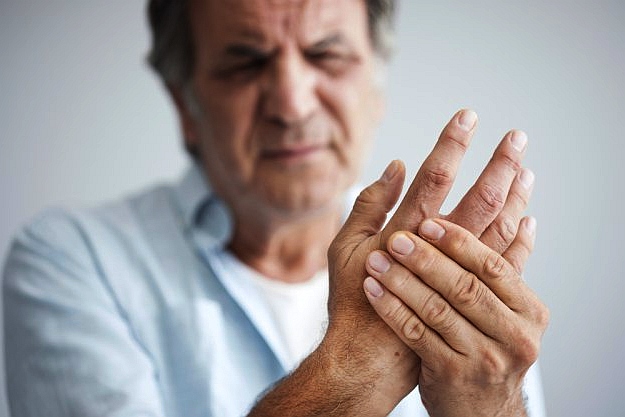

Finger joint pain can not only interfere with your daily life. It can also be debilitating. While some people may experience acute joint pain in their fingers, for others, it is chronic and seems to get worse over time. Understanding the causes of the painful joints and the possible treatments becomes essential for those suffering joint pain in their fingers.
Finger Joint Pain | Know the Causes and the Treatments
In This Article:
Possible Causes of Finger Joint Pain

Finger joint pain can happen for a wide variety of reasons. Some of the conditions are acute and will resolve with time while others can be chronic. The following may explain the creaky joints, as well as the pain and stiffness.
1. Trauma to the Area
Joint pain can occur from damage or injury to the hands or individual fingers. This can be the result of fractures, sprains, or strains. Usually, there will be pain and swelling. There may also be bruising around the damaged area, but you can remedy the symptoms with proper treatment.
2. Rheumatoid Arthritis
Rheumatoid Arthritis (or RA) is an autoimmune disease in which the body’s immune system begins to attack the healthy tissue in the body. While there is no known cause, RA might be triggered by either an infection or hormone changes. The condition occurs more often in women than in men and tends to be more likely to occur when there is a family history. There is also another subset called psoriatic arthritis. It is a form of arthritis that appears during a psoriasis flare-up. Many experts also believe the skin condition is an autoimmune disorder.
With RA, one may experience pain, swelling, stiffness, and warmth in the joints. As RA progresses, it can result in a contortion of the fingers. Flu-like symptoms and fatigue are also common.
3. Osteoarthritis
Osteoarthritis is a degenerative condition due to a breakdown of cartilage around the joints. Someone with osteoarthritis may present with symptoms such as bony lumps in the joint of the middle finger, pain radiating to the base of the thumb, morning finger stiffness, and difficulty with the pincer grasp.
4. Carpal Tunnel Syndrome
Finger joint pain that radiates through the wrist and up the arm could be a result of carpal tunnel syndrome. It is often the result of repetitive motion that leads to inflammation in the carpal tunnel, a bone structure of the wrist. The condition pushes down on the nerves resulting in pain.
5. Diabetic Nerve Pain
Those who suffer from diabetes may experience a numbness or pain throughout their fingers and finger joints. It is usually a result of damage to the nerves caused by the condition. This nerve damage, or peripheral neuropathy, often feels like a stinging or shooting pain.
6. Posttraumatic Arthritis
Even after injuries to the fingers or hands have healed, there is a chance posttraumatic arthritis pain can occur. It’s possible the injury accelerates a breakdown of the protective cartilage. It then causes inflammation in the joints. Symptoms of posttraumatic arthritis involve finger joint pain where the injury occurred. It may also result in a deformity of the finger that sustained the injury, swelling, and stiffness.
Diagnosing Finger Joint Pain

Determining the cause of the finger joint pain is often a process of elimination. Your doctor will start with taking a medical history and asking questions about your pain, such as:
- When did it start?
- What affects the pain?
- Does anything make the symptoms better?
- Have you had any hand or finger injuries?
- Are there any other symptoms accompanying it?
Your doctor will next perform a physical exam and check for specific deformities, which can indicate specific conditions. Your doctor may also order blood and imaging tests to check for injuries, tumors, or markers that may indicate RA.
Treatments for Finger Joint Pain

The treatment your doctor orders will largely depend on the cause of your finger joint pain as well as the symptoms. Some of the most common treatments include:
1. Medications
If you have RA, your doctor can prescribe various medications. These include non-steroidal anti-inflammatory drugs (NSAIDs), which help suppress the immune system and provide pain relief. Steroids and cortisone injections to battle severe inflammation and pain are also treatment options.
2. Resting the Joints
When you suffer joint injuries, you need to rest your joints for a period of time. If you have a chronic condition, you can find ways to use your fingers less or create less stress when you use them. Items such as easier-to-open doorknobs, latch enclosures for clothes, easy-to-switch light switches, and lighter kitchen materials such as pots, pans, and utensils can help achieve that.
3. Dietary Changes
Eating a diet that includes food that helps to reduce inflammation such as omega-3 fatty acids can help lower the inflammation in the body and reduce overall symptoms.
4. Hot and Cold Therapies
Heat can help eliminate and ease the stiffness of the joints. Applying ice for up to ten minutes at a time can also reduce the finger pain with swelling. If you suffer from both stiffness and swelling, you can alternate between the two therapies.
5. Physical and Occupational Therapy
Your doctor may recommend a physical therapist, an occupational therapist, or both to help you maintain control of your hand function and alleviate pain. Your therapist will recommend hand exercises to keep the tendons and ligaments flexible. This can involve strengthening exercises as well as stretching.
6. Splinting and Immobilization
You may be required to wear a protective brace designed to limit mobilization of your fingers. This will prevent injury and the recurrence of swelling. Splinting also reduces pain by limiting the motion of the nerves. A good example is a wrist brace or splint for finger joint pain caused by carpal tunnel syndrome.
7. Sulfur Creams
Pain relief creams such as Methylsulfonylmethane (MSM) can be helpful in reducing finger joint pain by increasing the absorption of sulfur. This is a naturally occurring compound that usually accumulates in and around the osseous structures. It, therefore, provides support to the bones, ligaments, joints, and tendons. Find an organic MSM cream to maximize the benefits.
8. Surgery
In rare instances where the bones become fused together due to damage, your doctor may recommend surgery to improve mobility. In cases where the joint is completely damaged, a surgical replacement may be recommended.
How to Prevent Finger Joint Pain

There are a few simple lifestyle changes that can reduce your risk of developing arthritis or many other conditions related to finger joint pain:
- Monitor your joint health
- Stay active
- Reduce sugar intake
- Eliminate smoking
- Perform regular hand exercises (exercise can also help relieve lower back pain)
- Practice good workplace habits
One of the ways to prevent finger joint pain is to do some finger exercises. Try these from mid brain:
Though there is no cure for arthritis and related conditions, with proper care and management, you will be able to reduce finger joint pain and other symptoms associated with them.
Do you have finger joint pain? What do you do for pain relief? Tell us your tips in the comments section below.
Up Next: The Eczema Friendly Diet | Anti Inflammatory Foods
